FRIDAY, SEPTEMBER 2
■ The Moon, nearly first quarter, poses just to the right of the head of Scorpius after dusk as shown below. The star closest to the Moon there is Delta Scorpii, the brightest in the area after Antares.
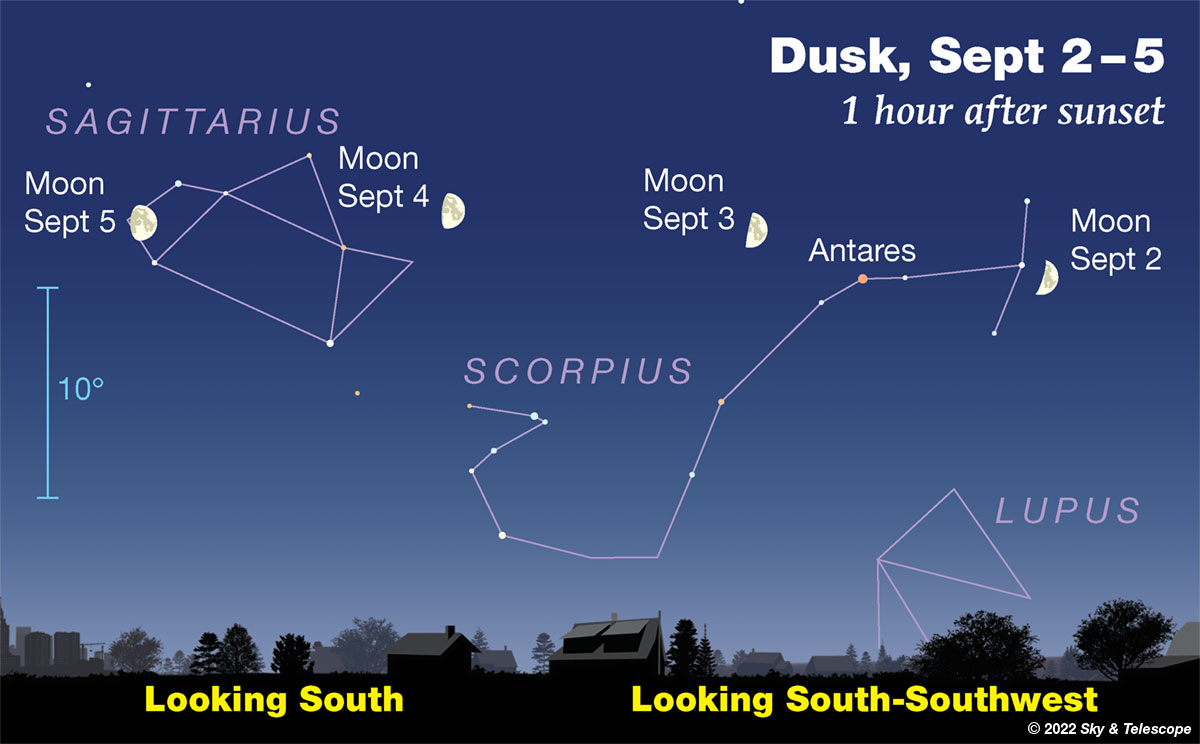
■ The two brightest stars (not planets) of September evenings are Vega high overhead and Arcturus in the west, both magnitude 0.
Draw a line from Vega down to Arcturus. A third of the way down you cross the dim Keystone of Hercules. Two thirds of the way you cross the dim semicircle of Corona Borealis with its one modestly bright star: Alphecca, the gem on the front of the crown.
■ A winter preview: Step out before the first light of dawn this week, and the sky displays the same starry panorama it does at dinnertime in early January. Orion is striding up in the southeast, with Aldebaran and then the Pleiades high above it. Sirius sparkles far down below Orion. The Gemini twins are lying on their sides well up in the east, left of Orion.
And brilliant Mars, currently dominating the scene near Aldebaran as shown below, is no planetary anachronism in this preview. The doings of its retrograde loop in the next four months will keep it in the general vicinity of Aldebaran — and make it even brighter in early January than it is now.
SATURDAY, SEPTEMBER 3
■ First-quarter Moon (exact at 2:08 p.m. EDT). Nightfall in North America finds the Moon in the south-southwest a few degrees upper left of Antares, as shown above. The next-brightest star there is Delta Scorpii, 8° to the right of Antares.
■ In the dawn of Sunday morning the 4th, Mars shines just 4½° above Aldebaran as shown below. This is essentially as close as they're going to get; Mars passes widely north of Aldebaran this week.
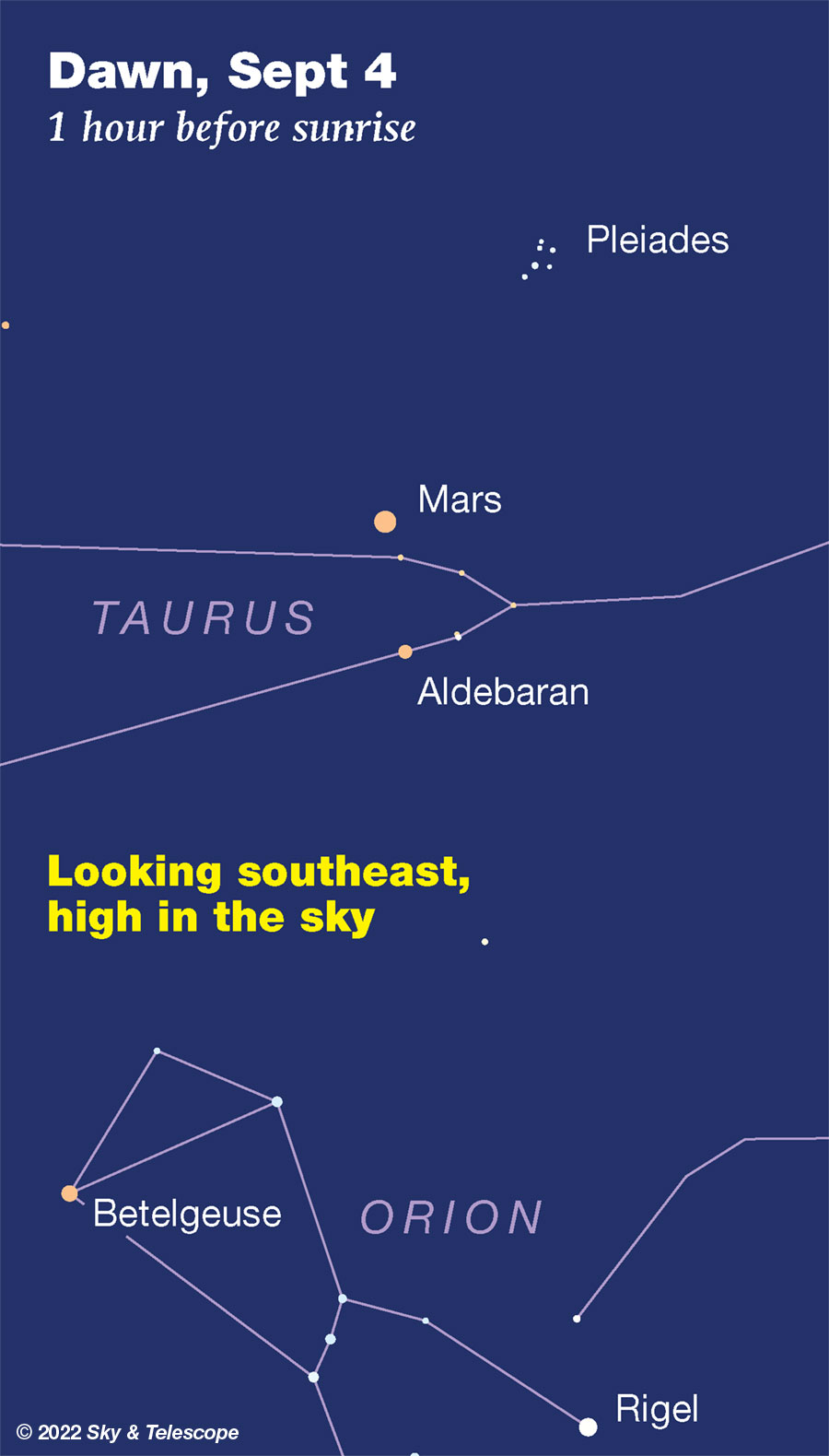
■ The asteroid 4 Vesta is just past opposition and showing itself at a relatively bright magnitude 6.2 this week. It's in western Aquarius about 8° southeast of 3rd-magnitude Delta Capricorni, Saturn's near neighbor. Use binoculars or a telescope with the finder chart in the August Sky & Telescope, page 49 (or the less detailed chart at Observe Vesta — and own a piece of it, too.)
SUNDAY, SEPTEMBER 4
■ How soon after sunset can you see the big Summer Triangle? Face east and look way up. Vega, the Triangle's brightest star, is nearly at the zenith (for skywatchers at mid-northern latitudes). Deneb is the brightest star a couple fists to Vega's east-northeast. Altair shines less high in the southeast, farther from Vega.
MONDAY, SEPTEMBER 5
■ Good lunar occultation. The waxing gibbous M00n shines in the handle of the Sagittarius Teapot this evening for the Americas. Moreover, the dark edge of the Moon will occult (cover) one of the handle's stars — Tau Sagittarii, magnitude 3.3 — for nearly all of the US, Canada, Mexico, and Central America. Use at least binoculars, preferably a telescope. Some times: Boston, 11:52 p.m. EDT; Miami, 11:48 p.m. EDT; Chicago, 10:35 p.m. CDT; Denver, 9:10 p.m. MDT; Phoenix, 7:46 p.m. MST. Near the West Coast the event happens in bright twilight and may not be observable.
See map and timetables for hundreds more locations. The text there has two long timetables: first for the star's disappearance, then for its reappearance from behind the Moon's bright limb (much harder to observe). Scroll to be sure you're using the right table. The first two letters in each entry are the country abbreviation ("CA" is Canada, not California.) UT is 4 hours ahead of EDT, 5 ahead of CDT, 6 ahead of MDT.
TUESDAY, SEPTEMBER 6
■ You can see in the stars that the season is changing: We've reached the time of year when, right at nightfall, Cassiopeia has climbed as high in the northeast as the Big Dipper has sunk in the northwest. Cas highlights the northern sky in early evening during the chilly fall-and-winter half of the year. The Big Dipper takes over for the milder evenings of spring and summer.
Almost midway between the two stands Polaris. It's currently a little above the midpoint between them.
WEDNESDAY, SEPTEMBER 7
■ Saturn shines upper left of the Moon this evening, as shown below.
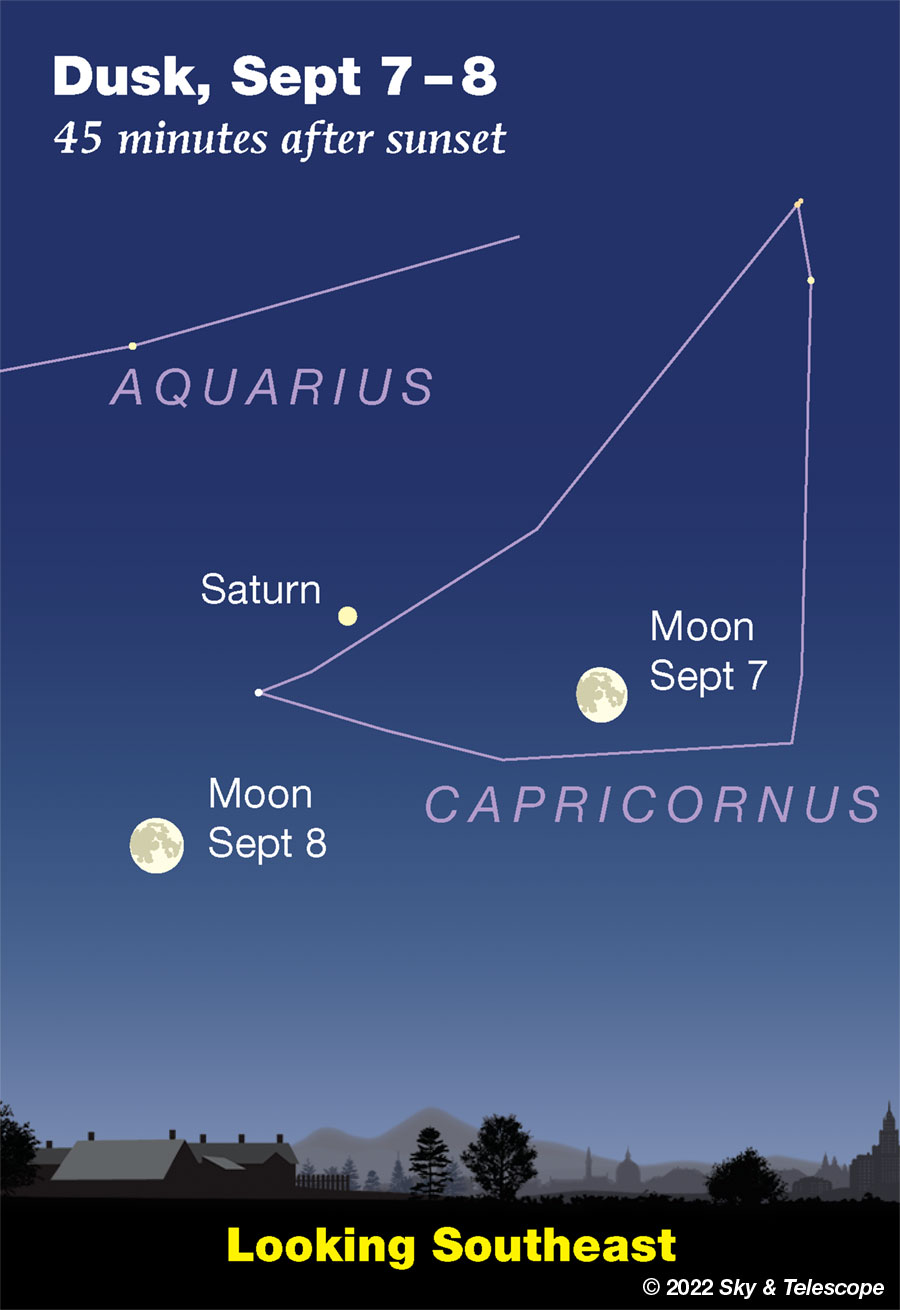
■ As dusk turns to night, Arcturus twinkles due west. It's getting lower every week. From Arcturus, the narrow, kite-shaped pattern of Bootes extends upper right by a little more than two fists at arm's length. Farther off to the right in the northwest, the Big Dipper is turning more and more level.
THURSDAY, SEPTEMBER 8
■ Now Saturn shines upper right of the almost-full Moon after dark. About midway between them is Delta Capricorni, magnitude 2.8. Can you pick it out through the moonlight?
By late evening, the scene moves westward and rotates clockwise so that Saturn is directly right of the Moon.
FRIDAY, SEPTEMBER 9
■ Full Moon tonight (exactly full at 5:59 a.m. Saturday morning EDT). The Moon rises in the east-southeast just after sunset. As the stars come out, you can see that the Moon is between bright Jupiter a couple of fists to its lower left, dimmer Saturn farther to the Moon's upper right (out of the frame below), and Fomalhaut, twinkling down to the Moon's lower right. The Moon forms a roughly equilateral triangle with those last two.
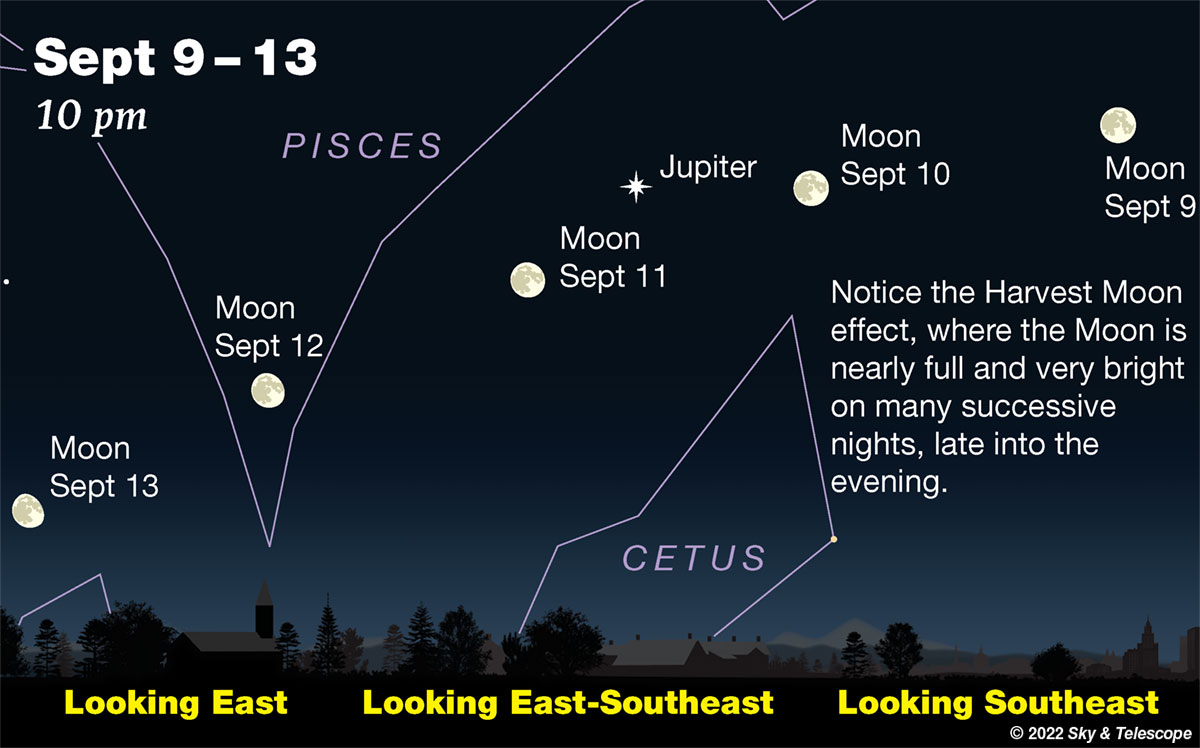
SATURDAY, SEPTEMBER 10
■ The Moon, a day past full, rises in late twilight with Jupiter now shining just one fist or less to its left, as shown above.
■ Vega now passes the zenith in late twilight about an hour after sunset, for those of us living in the world's mid-northern latitudes. Compared to our Sun, Vega is 2.5 times as large, about 1.7 times hotter, and 40 times brighter. But at a distance of 25 light-years it's 1.6 million times farther away.
This Week's Planet Roundup
Mercury is lost in the sunset.
Venus, magnitude –3.9, rises about a half hour after dawn gets under way. As dawn brightens, look for it very low in the east.
Venus passes through conjunction with Regulus, which only about 1% as bright, on Monday September 5th. That morning use good binoculars, or better yet a telescope at lowest power, to look for Regulus twinkling ¾° to Venus's right.
On the mornings before and after, September 4th and 6th, Venus and Regulus will be a little more than 1° apart and oriented differently.
Mars, magnitude –0.2 in Taurus, clears the east-northeast horizon around 11 p.m. and gains altitude for the rest of the night. It's three times as bright as Mars-colored Aldebaran, magnitude +0.9, sparkling a little below or lower right of it. Look for the Pleiades farther above Mars.
And far down below, there's Mars-colored Betelgeuse.
By the beginning of dawn this array is very high in the southeast. This the best time to examine Mars in a telescope: when we see it highest through the thinnest, steadiest air. Mars is 10 arcseconds in diameter and growing. It'll appear 17.2 arcseconds wide when closest to Earth on December 1st.
Jupiter glares low due east by late twilight. After dark it dominates the low east, then the higher southeast, at a bright magnitude –2.8. It's in an otherwise undistinguished area near the Pisces-Cetus border. It stands highest in the south around 2 a.m. daylight-saving time.
In a telescope Jupiter is 49 arcseconds wide across its equator, nearly its maximum possible, as it approaches its September 26th opposition. Jupiter this year is close to the perihelion of its 12-year orbit.
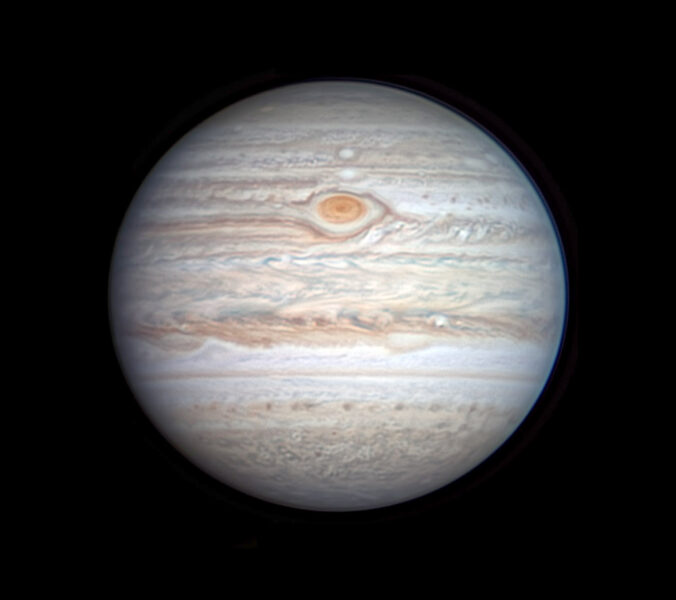
Saturn, magnitude +0.3 in eastern Capricornus, is three weeks past opposition, so as soon as twilight fades you can spot it already fairly well up in the southeast. It's at its highest and best in the south around 11 p.m.
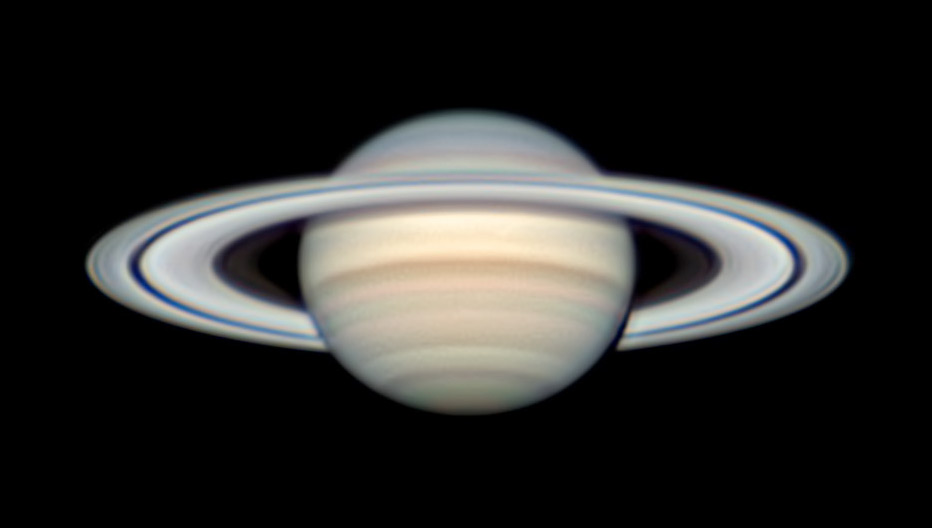
The gray band seen on the globe along the inner edge of the rings is not a shadow but the dim, semi-transparent C ring itself.
On the globe, the dark North Equatorial Belt seems to set off the brighter Equatorial Zone especially well this year.
Uranus, magnitude 5.7 in Aries, is west of Mars late at night.
Neptune, magnitude 7.8 at the Aquarius-Pisces border, is west of Jupiter.
All descriptions that relate to your horizon — including the words up, down, right, and left — are written for the world's mid-northern latitudes. Descriptions and graphics that also depend on longitude (mainly Moon positions) are for North America.
Eastern Daylight Time, EDT, is Universal Time minus 4 hours. (Universal Time is also called UT, UTC, GMT or Z time.)
Want to become a better astronomer? Learn your way around the constellations. They're the key to locating everything fainter and deeper to hunt with binoculars or a telescope.
This is an outdoor nature hobby. For an easy-to-use constellation guide covering the whole evening sky, use the big monthly map in the center of each issue of Sky & Telescope, the essential magazine of astronomy.
Once you get a telescope, to put it to good use you'll need a detailed, large-scale sky atlas (set of charts). The basic standard is the Pocket Sky Atlas (in either the original or Jumbo Edition), which shows stars to magnitude 7.6.

Next up is the larger and deeper Sky Atlas 2000.0, plotting stars to magnitude 8.5; nearly three times as many. The next up, once you know your way around, are the even larger Interstellarum atlas (stars to magnitude 9.5) or Uranometria 2000.0 (stars to magnitude 9.75). And be sure to read How to Use a Star Chart with a Telescope. It applies just as much to charts on your phone or tablet as to charts on paper.
You'll also want a good deep-sky guidebook. A beloved old classic is the three-volume Burnham's Celestial Handbook. An impressive more modern one is the big Night Sky Observer's Guide set (2+ volumes) by Kepple and Sanner.
Can a computerized telescope replace charts? Not for beginners, I don't think, and not on mounts and tripods that are less than top-quality mechanically, meaning heavy and expensive. And as Terence Dickinson and Alan Dyer say in their Backyard Astronomer's Guide, "A full appreciation of the universe cannot come without developing the skills to find things in the sky and understanding how the sky works. This knowledge comes only by spending time under the stars with star maps in hand."
![]() Audio sky tour. Out under the evening sky with your
Audio sky tour. Out under the evening sky with your
earbuds in place, listen to Kelly Beatty's monthly
podcast tour of the heavens above. It's free.
"The dangers of not thinking clearly are much greater now than ever before. It's not that there's something new in our way of thinking, it's that credulous and confused thinking can be much more lethal in ways it was never before."
— Carl Sagan, 1996
"Facts are stubborn things."
— John Adams, 1770
 5
5









Comments
Rod
September 2, 2022 at 5:40 am
I was out last night (evening of 01-Sep), some great stargazing weather with clear skies 🙂
Observed 2030-2230 EDT. Sunset 1937 EDT, Moon set 2225/2226 EDT. First Quarter Moon 03-Sep-2022 1808 UT or 1408 EDT. A target rich environment using 10x50 binoculars and my 90-mm refractor telescope. I used TeleVue 32-mm plossl for 31x views with true FOV ~ 96 arcminutes. Low power, wide field viewing tonight and with the binoculars. Early in the evening I enjoyed M11 at 31x, M22, and M8, the Lagoon Nebula. The waxing crescent Moon at 31x was lovely with earthshine and numerous craters visible along the terminator line. Some good lunar views 2030 EDT in Libra. Saturn a fine view even at 31x, rings distinct and the moons Titan and Rhea visible. Various faint stars around Saturn and its two moons distinct in the FOV in Capricornus. In the north up, mirror reverse view, Titan on the left and Rhea closer to the rings on the right side. Jupiter was enjoyable after 2200 EDT. The NEB and SEB stood out sharply and 4 Galilean moons. North up mirror reverse view, Ganymede on right side, Io, Europa, and Callisto on the right side. Fainter stars visible in the FOV too. 4 Vesta I used 10x50 binoculars to track down in Aquarius. Star hop 66 and 68 Aqr, 47 Aqr, 41 Aqr, and HIP109509 about 15 arcminutes or so from 4 Vesta. This was an easy and distinct star pattern with 10x50 binoculars to follow. Stellarium and Starry Night both show 4 Vesta a bit more than 1-degree angular separation from 41 Aqr double star. Since I last viewed 4 Vesta on 27-August, the asteroid moved quite a bit retrograde towards Capricornus. 41 Aqr, HIP109509, and 4 Vesta all in the 6th magnitude range and brightest objects in the area using 10x50 binoculars, easy to identify. Stellarium shows 4 Vesta mv + 5.80, theskylive.com site shows mv +6.20 tonight. This was a relaxing evening out under the Milky Way. M11, M22, M8, Saturn, Jupiter, and asteroid 4 Vesta looked at and earlier the Moon. Two moons at Saturn visible, 4 at Jupiter, and our Moon makes 7 moons seen in the solar system tonight.
You must be logged in to post a comment.
Rod
September 2, 2022 at 5:58 am
oops, Ganymede was on left side in the mirror reverse view last night 🙂
You must be logged in to post a comment.
Rod
September 4, 2022 at 5:38 am
A very lovely early morning sky now. I was out briefly this morning after 0500 EDT looking at Mars in Taurus, Aldebaran, M45 or Pleiades in Taurus, and Betelgeuse in Orion rising 🙂 Capella in Auriga, Gemini, Perseus. The early morning sky is a target rich environment. I may have to use my telescope and start viewing Mars, the planet is about 10 arcsecond angular size now. Some low power views of M45 will enjoyable too.
You must be logged in to post a comment.
Tony
September 6, 2022 at 9:43 am
In a very clear predawn sky shortly before 0600 PST September 6, I found Regulus quite easily in 16x50 binoculars and was *just* able to spot it without them. Never before have I seen Regulus earlier than September 9. Nearby Venus still dazzles, but with its elongation scarcely 12 degrees and decreasing it's getting very late in this morning apparition which began way back in January.
You must be logged in to post a comment.
Rod
September 6, 2022 at 10:06 am
Very good Tony. At my location in MD, Stellarium shows Venus and Regulus separated by a bit more than 1.5-degree. Their elevation angle is some 4-5 degrees still below a tree line in my viewing area. Glad to see others out enjoying some early morning stargazing too 🙂
You must be logged in to post a comment.
You must be logged in to post a comment.